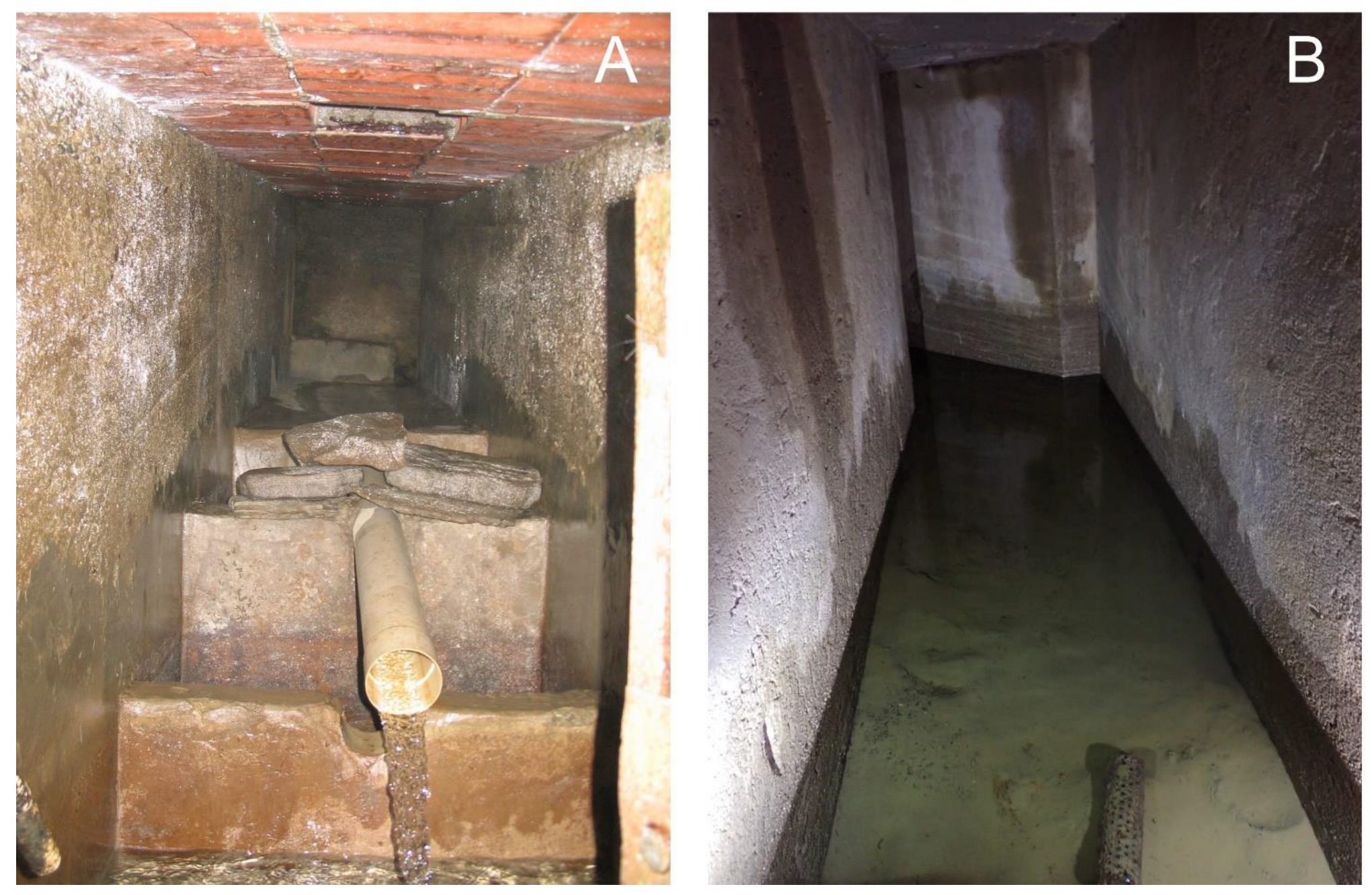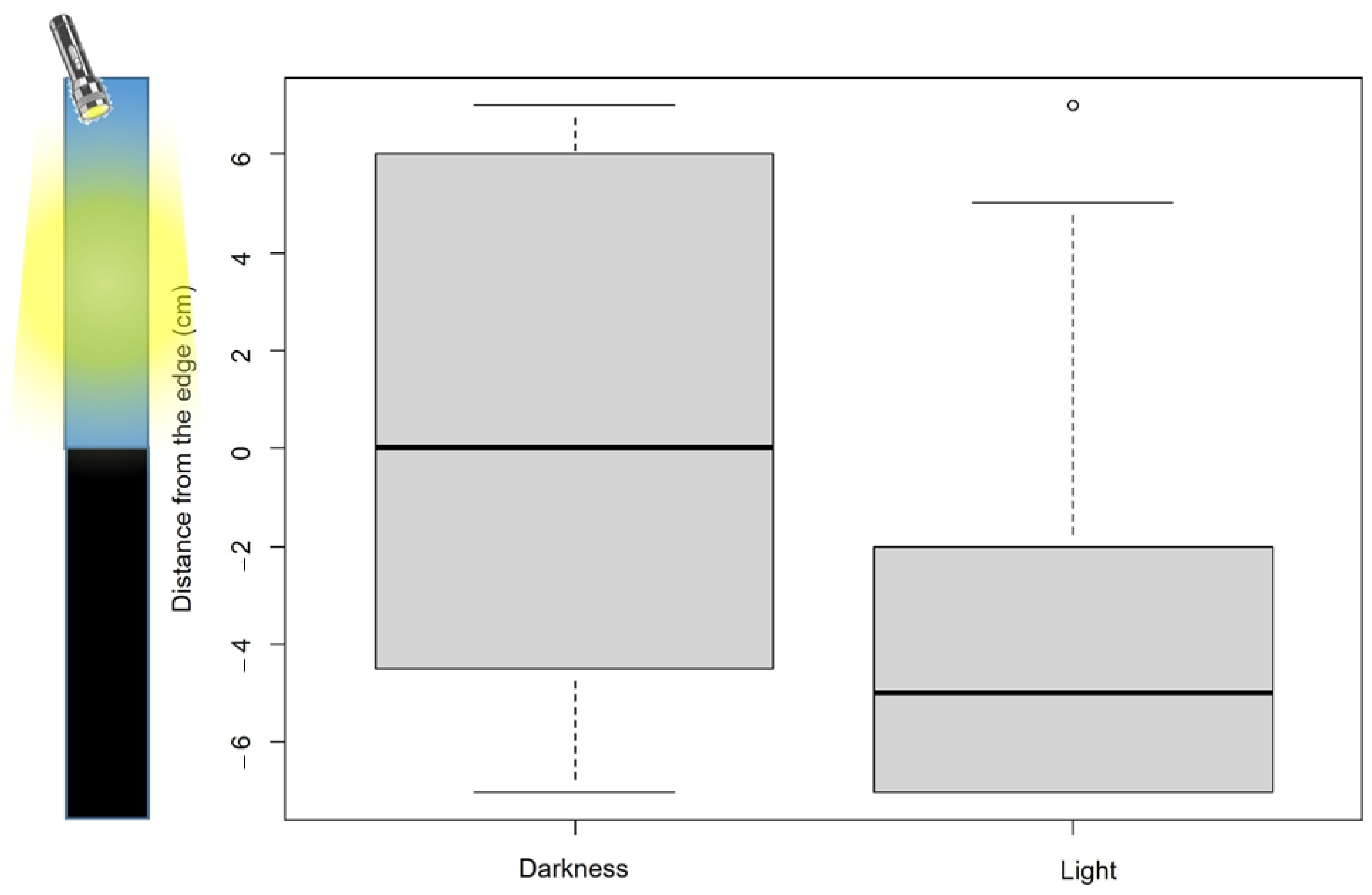Both Light Stimuli and Predation Risk Affect the Adult Behavior of a Stygobiont Crustacean
Abstract
1. Introduction
2. Materials and Methods
2.1. Study Species
2.2. Experimental System
2.3. Behavioural Tests
2.4. Statistical Analyses
3. Results
4. Discussion
Author Contributions
Funding
Institutional Review Board Statement
Data Availability Statement
Acknowledgments
Conflicts of Interest
References
- Carroll, T.M.; Thorp, J.H. Ecotonal shifts in diversity and functional traits in zoobenthic communities of karst springs. Hydrobiologia 2014, 738, 1–20. [Google Scholar] [CrossRef]
- Kark, S. Effects of Ecotones on Biodiversity. In Encyclopedia of Biodiversity, 2nd ed.; Levin, S.A., Ed.; Academic Press: Waltham, MA, USA, 2013; pp. 142–148. [Google Scholar]
- Konec, M.; Prevorčnik, S.; Sarbu, S.M.; Verovnik, R.; Trontelj, P. Parallels between two geographically and ecologically disparate cave invasions by the same species, Asellus aquaticus (Isopoda, Crustacea). J. Evol. Biol. 2015, 28, 864–875. [Google Scholar] [CrossRef] [PubMed]
- Thorp, J.H. Chapter 4—Functional Relationships of Freshwater Invertebrates. In Thorp and Covich’s Freshwater Invertebrates, 4th ed.; Thorp, J.H., Rogers, D.C., Eds.; Academic Press: Boston, MA, USA, 2015; pp. 65–82. [Google Scholar]
- Kark, S.; van Rensburg, B.J. Ecotones: Marginal or central areas of transition? Isr. J. Ecol. Evol. 2006, 52, 29–53. [Google Scholar] [CrossRef]
- Schilthuizen, M. Ecotone: Speciation-prone. Trends Ecol. Evol. 2000, 15, 130–131. [Google Scholar] [CrossRef] [PubMed]
- Di Lorenzo, T.; Cipriani, D.; Bono, P.; Rossini, L.; De Laurentiis, P.; Fiasca, B.; Pantani, C.; Galassi, D.M.P. Dynamics of groundwater copepod assemblages from the Mazzoccolo karstic spring (central Italy). Meiofauna Mar. 2005, 14, 97–103. [Google Scholar]
- Galassi, D.M.P.; Stoch, F.; Fiasca, B.; Di Lorenzo, T.; Gattone, E. Groundwater biodiversity patterns in the Lessinian Massif of northern Italy. Freshw. Biol. 2009, 54, 830–847. [Google Scholar] [CrossRef]
- Pacioglu, O.; Robertson, A. The invertebrate community of the chalk stream hyporheic zone: Spatio-temporal distribution patterns. Knowl. Manag. Aquat. Ecosyst. 2017, 418, 10. [Google Scholar] [CrossRef][Green Version]
- Premate, E.; Borko, Š.; Delić, T.; Malard, F.; Simon, L.; Fišer, C. Cave amphipods reveal co-variation between morphology and trophic niche in a low-productivity environment. Freshw. Biol. 2021, 66, 1876–1888. [Google Scholar] [CrossRef]
- Barzaghi, B.; Ficetola, G.F.; Pennati, R.; Manenti, R. Biphasic predators provide biomass subsidies in small freshwater habitats: A case study of spring and cave pools. Freshw. Biol. 2017, 62, 1637–1644. [Google Scholar] [CrossRef]
- MacAvoy, S.E.; Braciszewski, A.; Tengi, E.; Fong, D.W. Trophic plasticity among spring vs. cave populations of Gammarus minus: Examining functional niches using stable isotopes and C/N ratios. Ecol. Res. 2016, 31, 589–595. [Google Scholar] [CrossRef]
- Manenti, R.; Ficetola, G.F. Salamanders breeding in subterranean habitats: Local adaptations or behavioural plasticity? J. Zool. 2013, 289, 182–188. [Google Scholar] [CrossRef]
- von Fumetti, S.; Nagel, P.; Baltes, B. Where a springhead becomes a springbrook—A regional zonation of springs. Fundam. Appl. Limnol. 2007, 169, 37–48. [Google Scholar] [CrossRef]
- Manenti, R.; Barzaghi, B. Diel activity of Niphargus amphipods in spring habitats. Crustaceana 2021, 94, 705–721. [Google Scholar]
- Fišer, C.; Pipan, T.; Culver, D.C. The vertical extent of groundwater metazoans: An ecological and evolutionary perspective. Bioscience 2014, 64, 971–979. [Google Scholar] [CrossRef]
- Fišer, Z.; Novak, L.; Lustrik, R.; Fiser, C. Light triggers habitat choice of eyeless subterranean but not of eyed surface amphipods. Sci. Nat. 2016, 103, 7. [Google Scholar] [CrossRef] [PubMed]
- Culver, D.C.; Pipan, T. Biology of Caves and Other Subterranean Habitats, 2nd ed.; Oxford University Press: New York, NY, USA, 2019; pp. 1–301. [Google Scholar]
- Romero, A. Cave Biology: Life in Darkness; Cambridge University Press: New York, NY, USA, 2009. [Google Scholar]
- Mammola, S. Finding answers in the dark: Caves as models in ecology fifty years after Poulson and White. Ecography 2019, 42, 1331–1351. [Google Scholar] [CrossRef]
- Poulson, T.L.; White, W.B. The cave environment. Science 1969, 165, 971–981. [Google Scholar] [CrossRef]
- Romero, A. The Evolution of Cave Life. Am. Sci. 2011, 99, 144–151. [Google Scholar] [CrossRef]
- Durand, J.P. Ocular Development and Involution in European Cave Salamander, Proteus anguinus Laurenti. Biol. Bull. 1976, 151, 450–466. [Google Scholar] [CrossRef]
- Moldovan, O.T.; Kováč, L.; Halse, S. Cave Ecology; Springer: Cham, Switzerland, 2018. [Google Scholar]
- Moran, D.; Softley, R.; Warrant, E.J. The energetic cost of vision and the evolution of eyeless Mexican cavefish. Sci. Adv. 2015, 1, e1500363. [Google Scholar] [CrossRef]
- Friedrich, M. Biological Clocks and Visual Systems in Cave-Adapted Animals at the Dawn of Speleogenomics. Integr. Comp. Biol. 2013, 53, 50–67. [Google Scholar] [CrossRef] [PubMed]
- Jeffery, W.R. Cavefish as a model system in evolutionary developmental biology. Dev. Biol. 2001, 231, 1–12. [Google Scholar] [CrossRef] [PubMed]
- Borowsky, B. Responses to light in two eyeless cave dwelling amphipods (Niphargus ictus and Niphargus frasassianus). J. Crustac. Biol. 2011, 31, 613–616. [Google Scholar] [CrossRef]
- Soares, D.; Niemiller, M.L. Sensory Adaptations of Fishes to Subterranean Environments. Bioscience 2013, 63, 274–283. [Google Scholar] [CrossRef]
- Manenti, R.; Piazza, B. Between darkness and light: Spring habitats provide new perspectives for modern researchers on groundwater biology. PeerJ 2021, 9, e11711. [Google Scholar] [CrossRef]
- Barzaghi, B.; Blaimont, P.; Manenti, R. Detection of non-consumptive effects of predation and intraspecific aggression in fire salamander larvae: Environmental issues. North-West J. Zool. 2020, 16, 74–77. [Google Scholar]
- Manenti, R.; Siesa, M.E.; Ficetola, G.F. Odonata occurence in caves: Active or accidentals? A new case study. J. Cave Karst Stud. 2013, 75, 205–209. [Google Scholar] [CrossRef]
- Manenti, R.; Lunghi, E.; Barzaghi, B.; Melotto, A.; Falaschi, M.; Ficetola, G.F. Do salamanders limit the abundance of groundwater invertebrates in subterranean habitats? Diversity 2020, 12, 161. [Google Scholar] [CrossRef]
- Manenti, R.; Pezzoli, E. Think of what lies below, not only of what is visible above, or: A comprehensive zoological study of invertebrate communities of spring habitats. Eur. Zool. J. 2019, 86, 272–279. [Google Scholar] [CrossRef]
- Wilhelm, F.M.; Taylor, S.J.; Adams, G.L. Comparison of routine metabolic rates of the stygobite, Gammarus acherondytes (Amphipoda: Gammaridae) and the stygophile, Gammarus troglophilus. Freshw. Biol. 2006, 51, 1162–1174. [Google Scholar] [CrossRef]
- Pezzoli, E.; Lemme, M. I Molluschi delle “Acque sotterranee”. X° Contributo per la Provincia di Brescia (VIII° Regione Lombardia). Revisione delle stazioni edite e proseguimento della mappatura sul territorio. Particolare ricerca sulla tanatocenosi che si accumula nelle vasche di decantazione dei manufatti di captazione di sorgenti. Monogr. Nat. Brescia 2003, 26, 1–240. [Google Scholar]
- Stoch, F. Isopodi ed anfipodi (Crustacea, Malacostraca) della Provincia di Bergamo: Note sulle specie rinvenute nelle grotte e nelle sorgenti. In I Molluschi Delle Sorgenti e Delle ‘Acque Sotterranee’, IX Aggiornamento al Censimento; Pezzoli, E., Spelta, F., Eds.; Monografie di Natura Bresciana: Brescia, Italy, 2000; Volume 24, pp. 231–241. [Google Scholar]
- Ficetola, G.F.; Manenti, R.; De Bernardi, F.; Padoa-Schioppa, E. Can patterns of spatial autocorrelation reveal population processes? An analysis with the fire salamander. Ecography 2012, 35, 693–703. [Google Scholar] [CrossRef]
- Pezzoli, E. I Molluschi crenobionti e stigobionti presenti in Italia. Censimento delle stazioni: VII aggiornamento. Quad. Civ. Staz. Idrobiol. Milano. 1996, 21, 111–118. [Google Scholar]
- Hesselmann, G. Applying Linear Mixed Effects Models (LMMs) in Within-Participant Designs With Subjective Trial-Based Assessments of Awareness—A Caveat. Front. Psychol. 2018, 9, 788. [Google Scholar] [CrossRef]
- Piepho, H.-P. Multiple Treatment Comparisons in Linear Models When the Standard Error of a Difference is not Constant. Biom. J. 2000, 42, 823–835. [Google Scholar] [CrossRef]
- Field, A.; Miles, J.; Field, Z. Discovering Statistics Using R; SAGE Publications: London, UK, 2015. [Google Scholar]
- Bolker, B.M.; Brooks, M.E.; Clark, C.J.; Geange, S.W.; Poulsen, J.R.; Stevens, M.H.H.; White, J.S. Generalized linear mixed models: A practical guide for ecology and evolution. Trends Ecol. Evol. 2008, 24, 127–135. [Google Scholar] [CrossRef]
- Zuur, A.F.; Ieno, E.N.; Walker, N.J.; Saveliev, A.A.; Smith, G.M. Mixed Effects Models and Extensions in Ecology with R; Springer: Berlin/Heidelberg, Germany, 2009; p. 680. [Google Scholar]
- Ginet, R. Ecologie, éthologie et biologie de” Niphargus”(Amphipodes Gammaridés hypogés). Ann. Speleol. 1960, 15, 127–237. [Google Scholar]
- Vandel, A. Biospeleologie: La Biologie des Animaux Cavernicoles; Gauthiers-Villars: Paris, France, 1964; Volume XVIII, p. 619. [Google Scholar]
- Kennedy, M.D.; Barberio, A.; Connaughton, V.P. Novel experimental apparatus for laboratory measurements of phototaxis: A comparison between amphipod species. J. Crustac. Biol. 2022, 42, ruab085. [Google Scholar] [CrossRef]
- Kennedy, M.D.; Connaughton, V.P. Differential effects of fluoxetine on the phototactic behavior of 3 amphipod species (Crustacea; Amphipoda). Environ. Toxicol. Pharmacol. 2022, 93, 103889. [Google Scholar] [CrossRef]
- Manenti, R.; Ficetola, G.F.; Bianchi, B.; De Bernardi, F. Habitat features and distribution of Salamandra salamandra in underground springs. Acta Herpetol. 2009, 4, 143–151. [Google Scholar]
- Breder, C.M.J.; Rasquin, P. Comparative Studies in the Light Sensitivity of Blind Characins from a Series of Mexican Caves. Bull. Am. Mus. Nat. Hist. 1947, 89, 5. [Google Scholar]
- Merker, E. Lichtsinn und allgemeine LIchtempfindlichkeit. Zool Anz. 1929, 4, 29–32. [Google Scholar]
- Viaud, G. Recherches experimentales sur le Phototropisme des Planaires. Behaviour 1950, 2, 163–216. [Google Scholar] [CrossRef]
- Pasini, A.; Manenti, R.; Rothbacher, U.; Lemaire, P. Antagonizing Retinoic Acid and FGF/MAPK Pathways Control Posterior Body Patterning in the Invertebrate Chordate Ciona intestinalis. PLoS ONE 2012, 7, e46193. [Google Scholar] [CrossRef]
- Premate, E.; Zagmajster, M.; Fišer, C. Inferring predator–prey interaction in the subterranean environment: A case study from Dinaric caves. Sci. Rep. 2021, 11, 21682. [Google Scholar] [CrossRef]
- James, W.R.; McClintock, J.B. Anti-predator responses of amphipods are more effective in the presence of conspecific chemical cues. Hydrobiologia 2017, 797, 277–288. [Google Scholar] [CrossRef]
- Jermacz; Kletkiewicz, H.; Krzyżyńska, K.; Klimiuk, M.; Kobak, J. Does global warming intensify cost of antipredator reaction? A case study of freshwater amphipods. Sci. Total Environ. 2020, 742, 140474. [Google Scholar] [CrossRef]
- Jermacz, Ł.; Andrzejczak, J.; Arczyńska, E.; Zielska, J.; Kobak, J. An enemy of your enemy is your friend: Impact of predators on aggregation behavior of gammarids. Ethology 2017, 123, 627–639. [Google Scholar] [CrossRef]
- Jermacz, Ł.; Dzierżyńska-Białończyk, A.; Kobak, J. Predator diet, origin or both? Factors determining responses of omnivorous amphipods to predation cues. Hydrobiologia 2017, 785, 173–184. [Google Scholar] [CrossRef]




| . | Estimate | NumDF | DenDF | F | p |
|---|---|---|---|---|---|
| Light stimuli | −4.76 | 1 | 145 | 49.04 | <0.001 |
| Reared with predators vs. without predators | −0.68 | 1 | 145 | 9.10 | <0.01 |
| Tanks without predators, intermittent-light conditions vs. constant darkness | 0.54 | 1 | 145 | 1.01 | 0.31 |
| Tanks with two predators vs. tanks with only one predator | −0.98 | 1 | 145 | 2.51 | 0.11 |
| Tanks with two predators, intermittent-light conditions vs. constant darkness | −4.85 | 1 | 145 | 3.63 | 0.06 |
| Tanks with one predator, intermittent-light conditions vs. constant darkness | −0.83 | 1 | 145 | 2.18 | 0.14 |
Disclaimer/Publisher’s Note: The statements, opinions and data contained in all publications are solely those of the individual author(s) and contributor(s) and not of MDPI and/or the editor(s). MDPI and/or the editor(s) disclaim responsibility for any injury to people or property resulting from any ideas, methods, instructions or products referred to in the content. |
© 2023 by the authors. Licensee MDPI, Basel, Switzerland. This article is an open access article distributed under the terms and conditions of the Creative Commons Attribution (CC BY) license (https://creativecommons.org/licenses/by/4.0/).
Share and Cite
Galbiati, M.; Lapadula, S.; Forlani, M.; Barzaghi, B.; Manenti, R. Both Light Stimuli and Predation Risk Affect the Adult Behavior of a Stygobiont Crustacean. Diversity 2023, 15, 290. https://doi.org/10.3390/d15020290
Galbiati M, Lapadula S, Forlani M, Barzaghi B, Manenti R. Both Light Stimuli and Predation Risk Affect the Adult Behavior of a Stygobiont Crustacean. Diversity. 2023; 15(2):290. https://doi.org/10.3390/d15020290
Chicago/Turabian StyleGalbiati, Matteo, Stefano Lapadula, Martina Forlani, Benedetta Barzaghi, and Raoul Manenti. 2023. "Both Light Stimuli and Predation Risk Affect the Adult Behavior of a Stygobiont Crustacean" Diversity 15, no. 2: 290. https://doi.org/10.3390/d15020290
APA StyleGalbiati, M., Lapadula, S., Forlani, M., Barzaghi, B., & Manenti, R. (2023). Both Light Stimuli and Predation Risk Affect the Adult Behavior of a Stygobiont Crustacean. Diversity, 15(2), 290. https://doi.org/10.3390/d15020290







